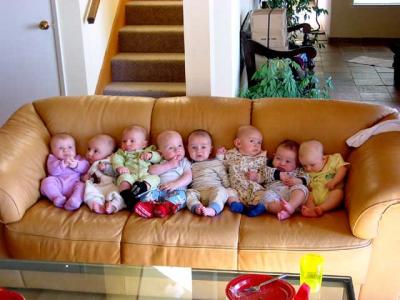I know lots of people think kids are the cutest thing since sliced bread but really there is just too many humans on this planet. Growth in the human population abounds despite falling fertility rates, and where it heads in the future will continue to confound demographers, according to the latest Vital Sign Update from the Worldwatch Institute. With the number of women of childbearing age growing and future fertility trends unpredictable, closing the “gender gapâ€â€”the difference between women’s health, economic, educational, and political status relative to men–—may be one key to slowing population growth.
Robert Engelman, Worldwatch Vice President for Programs and author of the forthcoming book More: Population, Nature, and What Women Want, challenges assertions that world population is “expected†to be slightly higher than 9 billion people in 2050, up from today’s 6.7 billion. Demographers with the United Nations and other agencies produce a range of population projections, since there’s no certainty about future fertility rates or life expectancies. The projections, which range from less than 8 billion to nearly 11 billion people worldwide by mid-century, all assume continued declines in childbearing, which are not guaranteed to materialize. No matter what number you go with the number is one thing, too high.
“Sustaining further declines in childbearing and increases in life expectancy…will require continued efforts by governments to improve access to good health care, and both trends could be threatened by environmental or social deterioration in future decades,†Engelman writes. “The uncertain future of these factors makes population growth harder to predict than most people realize.â€
While life expectancies have been rising and fertility rates have been falling worldwide over the past few decades, government spending on international family planning and related reproductive health services has stagnated in recent years do in no small part to President Bush’s insistence on “abstinence only” campaigns. Current spending is well below what would be needed for global population to stabilize based on low birthrates.
“Governments will need to increase their spending significantly in these areas before fertility rates are likely to reach the low levels assumed in the most commonly cited population projections,†Engelman said. One result, he noted, is that half of all women from 15 to 49 in developing countries risk unintended pregnancy because they are sexually active but using contraception improperly or not at all.
In contrast to the global trend, fertility actually ticked upward in 2006 in the United States, which has by far the largest population (about 303 million) among industrial nations. The average number of children born per U.S. woman climbed to 2.1, its highest rate since 1971. Demographers are not sure why this increase has occurred but cite greater proportions of young people lacking easy and affordable access to sexuality education, contraception, and abortion services as likely reasons. Hmm, we cut funding for abortion, and contraception and the results MORE BABIES. Who would have thunk it?
One positive indication for the future of population worldwide is a correlation between high female status and low fertility, based on statistical work by the United Nations Population Division and the World Economic Forum.
“Tackling the gender gap between men and women worldwide is critical for the well-being of half the world’s population,†Engelman said. “An added benefit is that when women have the same health status, rights, and opportunities as men, population growth is more likely to slow and eventually end. That is essential for both social and environmental sustainability.â€
Now don’t get me wrong I don’t want to kill people. That would be silly, what I want to do is slow down the rate at which we make new people and allow nature to do the rest. People unfortunately die every day from a host of reasons (lets hope they have all had a nice long life filled with love and happiness), by slowing down the birth rate we in essence lower the population of humans without actively harming anyone. One key way to help the environment is to take some of the strain off of it.
If there was only 1000 people on the whole planet it would be almost impossible for us to have any impact on the global ecology, but 9 Billion people, or 10 BILLION people certainly can. We will run out of food, run out of fresh water, run out of oil, run out of a lot of things. The results will be very very ugly, nature has a way of dealing with overpopulation. It is far more humane to everyone (everywhere) to provide access to family planning, condoms, and education.
